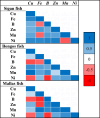Health risks and contamination degrees associated with heavy metals in three coastal fish from the Red Sea
- PMID: 40890375
- PMCID: PMC12402121
- DOI: 10.1038/s41598-025-15942-5
Health risks and contamination degrees associated with heavy metals in three coastal fish from the Red Sea
Abstract
This study focuses on the levels of heavy metals (HMCs) in the commonly consumed marine fish from the Aqaba Gulf, Red Sea, Egypt. It evaluates the effectiveness of soaking treatments as a novel approach to reducing HMCs. The order of metals varied among species, with sigan and bongos fish following Mn < Ni < Cu < B < Fe < Zn, while mallas fish followed Mn < Ni < Cu < Zn < Fe < B. The highest level in untreated samples was observed in sigan for Zn (67.60 ± 2.34 µg/g ww-b), while the lowest was recorded in bongos for Mn (0.96 ± 0.07 µg/g ww-b). Soaking treatments significantly reduced HMCs in all species, as confirmed by environmental risk indices. Risk assessments revealed that the hazard index (HI-HMCs) values for children often exceeded the acceptable threshold of HI-HMCs ≤ 1, suggesting potential health risks despite reductions achieved through soaking. Among the soaking methods, the mixed soaked treatment, which combined salt and apple vinegar, showed the most pronounced reduction in metal levels, demonstrating a synergistic effect. In conclusion, while soaking treatments effectively mitigate HMCs contamination, further efforts are required to develop safer fish processing methods, particularly to safeguard vulnerable groups like children.
Keywords: Carcinogenic and non-carcinogenic risks; Environmental assessment; Heavy metals; Pollution mitigation; Soaking treatments.
© 2025. The Author(s).
Conflict of interest statement
Declarations. Competing interests: The authors declare no competing interests.
Figures






References
-
- Mehanna, S. Population dynamics and assessment of the snubnose emperor L. ramak (L. bungus) from the Gulf of Aqaba, Egypt. Egypt. J. Aquat. Biol. Fish.27, 643–654. 10.21608/ejabf.2023.305278 (2023).
-
- Mohamedein, L. I., El-Moselhy, K. M. & El-Sawy, M. A. Environmental impact assessment (EIA) of As, Se, Sn, and Hg in water and sediments from the Egyptian Red Sea ports. Blue Econ.10.57241/2805-2994.1001 (2023).
-
- Youssef, D. H. & El-Said, G. F. Assessment of some trace elements in surface sediments of Aqaba Gulf, Egypt. Environ. Monit. Assess.180, 229–242. 10.1007/s10661-010-1784-x (2011). - PubMed
-
- Elgendy, A. R., El-Sawy, M. A., Hassan, A. R. & Khaled, S. S. Anthropogenic heavy metal pollution in Nuweibaa, Gulf of Aqaba, Egypt: A threat to marine environment and water quality. Egypt. J. Aquat. Biol. Fish.28, 1877–1896. 10.21608/ejabf.2024.344169 (2024).
-
- Younis, A. M., Hanafy, S., Raafa, M. & El-Naggar, M. H. Evaluation of pollution status and risk assessment along the Al-Shuaibah coastline, the Red Sea, Saudi Arabia. Egypt. J. Aquat. Biol. Fish.27, 923–945 (2023).
MeSH terms
Substances
LinkOut - more resources
Full Text Sources
Medical

